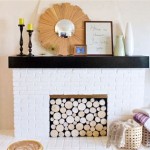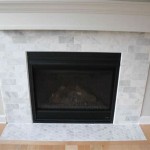Can You Resurface a Fireplace? A Comprehensive Guide
Fireplaces, often the focal point of a living room, contribute significantly to the aesthetic appeal and comfort of a home. However, over time, the original surface of a fireplace can become worn, damaged, or simply outdated. Resurfacing a fireplace offers a cost-effective alternative to a complete replacement, allowing homeowners to rejuvenate their space and enhance its visual appeal without incurring substantial construction expenses.
The feasibility of resurfacing a fireplace depends on several factors, including the existing material, the extent of the damage, and the desired aesthetic outcome. This article provides a comprehensive guide on resurfacing a fireplace, covering various techniques, materials, and considerations for a successful project.
Understanding the Existing Fireplace Material
Before embarking on a resurfacing project, it is imperative to accurately identify the existing material of the fireplace. The most common materials include brick, stone, concrete, and tile. Each material requires specific preparation techniques and compatible surfacing materials.
Brick Fireplaces: Brick fireplaces are known for their durability and classic appeal. However, they can become stained, chipped, or cracked over time. Resurfacing options include applying a thin coat of mortar, painting, or installing a veneer of stone or brick.
Stone Fireplaces: Stone fireplaces, whether natural or manufactured, offer a rustic and elegant aesthetic. Resurfacing options include cleaning and sealing the existing stone, applying a stain or color enhancer, or installing a new layer of stone veneer.
Concrete Fireplaces: Concrete fireplaces offer versatility in design and can be molded into various shapes and textures. Resurfacing options include applying a concrete overlay, staining, or adding decorative aggregates.
Tile Fireplaces: Tile fireplaces provide a wide range of design possibilities with various colors, patterns, and textures. Resurfacing options include replacing individual tiles, applying a tile overlay, or installing a new tile design.
Proper identification of the existing material is crucial to selecting the appropriate resurfacing method and ensuring a long-lasting and aesthetically pleasing result.
Preparation is Key: Essential Steps Before Resurfacing
The preparation phase is a critical component of any fireplace resurfacing project. Neglecting proper preparation can lead to adhesion issues, premature failure of the new surface, and an unsatisfactory final appearance.
Cleaning and Repair: The first step involves thoroughly cleaning the existing fireplace surface to remove dirt, dust, soot, and any loose debris. A wire brush, pressure washer (for outdoor applications), or specialized cleaning solutions may be necessary depending on the material and level of contamination. Any cracks, chips, or other damage should be repaired before proceeding. Mortar cracks can be filled with patching mortar, while larger structural damage may require professional assessment and repair.
Surface Preparation: Depending on the chosen resurfacing method, it may be necessary to prepare the existing surface to promote adhesion. This can involve roughening the surface with a grinder or applying a bonding agent. For smooth surfaces like tile, a primer specifically designed for tile adhesion may be required. The specific preparation steps will vary based on the chosen resurfacing material and the existing substrate.
Protection: It is essential to protect the surrounding areas from dust, debris, and spills during the resurfacing process. Drop cloths, masking tape, and plastic sheeting should be used to cover floors, walls, and furniture. Proper ventilation is also important, especially when working with materials that emit fumes or dust.
Thorough preparation is essential for a successful and durable fireplace resurfacing project. Taking the time to properly clean, repair, and prepare the surface will ensure optimal adhesion and a long-lasting, aesthetically pleasing result.
Common Resurfacing Methods and Materials
The choice of resurfacing method and materials will depend on the homeowner’s desired aesthetic, budget, and the existing condition of the fireplace. Several options are available, each with its own advantages and disadvantages.
Mortar Wash: Applying a mortar wash, also known as a German Smear, is a popular technique for softening the appearance of brick fireplaces. This involves applying a thin layer of mortar over the existing brick, creating a textured, whitewashed look. The mortar can be applied in a variety of ways, from a smooth, even coat to a more rustic, irregular finish. This method is relatively inexpensive and can be a good option for updating the look of a brick fireplace without completely covering it.
Stone Veneer: Stone veneer is a thin layer of natural or manufactured stone that is applied to the existing fireplace surface. This can dramatically transform the look of the fireplace, creating a more rustic or elegant appearance. Stone veneer is available in a wide range of colors, textures, and styles. It is typically applied with mortar and requires careful planning and installation to ensure a secure and aesthetically pleasing result.
Tile Overlay: Tile overlay involves installing new tiles over the existing tiles. This can be a good option for updating the look of a tile fireplace without having to remove the old tiles. It is important to choose tiles that are compatible with the existing surface and to use a strong adhesive. Proper surface preparation is essential to ensure that the new tiles adhere properly. Grout selection is also important for achieving the desired aesthetic.
Concrete Overlay: Concrete overlay involves applying a thin layer of concrete over the existing surface. This can be a good option for creating a modern, industrial look. Concrete overlays can be stained, textured, or polished to achieve a variety of finishes. Proper surface preparation and the use of a bonding agent are essential to ensure that the concrete overlay adheres properly.
Painting: Painting a fireplace is a relatively inexpensive and easy way to update its appearance. However, it is important to use a heat-resistant paint specifically designed for fireplaces. The existing surface must be properly cleaned and primed before painting. Painting can be a good option for brick, concrete, or even stone fireplaces, but it may not be the most durable solution, especially in areas exposed to high heat.
Careful consideration of the various resurfacing methods and materials is crucial for achieving the desired aesthetic and ensuring a long-lasting and durable result. Factors such as budget, existing fireplace material, and desired level of maintenance should be taken into account when making a decision.
Addressing Fire Safety Considerations
Fire safety is paramount when resurfacing a fireplace. Any resurfacing project must comply with local building codes and safety regulations. It is essential to use fire-resistant materials and to maintain proper clearances around the firebox.
Non-Combustible Materials: Any materials used near the firebox must be non-combustible. This includes mortar, stone veneer, and tile. Avoid using flammable materials such as wood, fabric, or paper near the firebox.
Clearances: Maintain proper clearances around the firebox to prevent overheating and fire hazards. Consult local building codes for specific clearance requirements. Generally, combustible materials should be kept at a safe distance from the firebox opening.
Professional Inspection: Consider having a professional inspect the fireplace after resurfacing to ensure that it is safe to use. A qualified fireplace technician can check for any potential hazards and provide recommendations for safe operation.
Carbon Monoxide Detectors: Ensure that functioning carbon monoxide detectors are installed in the home, especially near the fireplace. Carbon monoxide is a colorless, odorless gas that can be deadly. Carbon monoxide detectors provide an early warning of dangerous levels of carbon monoxide in the air.
Prioritizing fire safety is essential when resurfacing a fireplace. Using fire-resistant materials, maintaining proper clearances, and obtaining professional inspections will help ensure the safe operation of the fireplace.
DIY vs. Professional Resurfacing
The decision to resurface a fireplace as a DIY project or to hire a professional depends on several factors, including the homeowner’s skill level, experience, and the complexity of the project. While DIY projects can save money, they also require significant time, effort, and expertise.
DIY Considerations: DIY fireplace resurfacing projects can be a rewarding experience for homeowners with basic construction skills and a willingness to learn. However, it is important to carefully assess the project’s complexity and potential challenges before embarking on a DIY project. The homeowner should be comfortable with tasks such as mixing mortar, cutting tile, and applying stone veneer. It is also important to have access to the necessary tools and equipment. DIY pros include cost savings and personalize satisfaction. Cons includes the risk of errors, requires more time, and potential for injury.
Professional Installation: Hiring a professional fireplace contractor ensures that the resurfacing project is completed correctly and safely. Professional contractors have the experience, knowledge, and equipment to handle complex projects and to ensure that all work is compliant with local building codes. Pros includes guaranteed quality, reduced risk, and faster completion. Cons associated with professional installation include higher costs and reliance on external expertise.
Ultimately, the decision to DIY or hire a professional should be based on a careful assessment of the homeowner’s capabilities, resources, and the complexity of the project. If there is any doubt about the homeowner’s ability to complete the project safely and correctly, it is always best to hire a professional.
Resurfacing a fireplace can revitalize a living space and enhance the overall aesthetic appeal of a home. By carefully considering the existing fireplace material, preparing the surface properly, selecting appropriate resurfacing methods and materials, and prioritizing fire safety, homeowners can achieve a successful and long-lasting result, whether through a carefully planned DIY project or by engaging the services of a qualified professional.

15 Fabulous Fireplace Refacing Ideas Average But Inspired

Reface A Fireplace With The Look Of Stone Or Brick Barron Designs

10 Fireplace Makeover Ideas Before And After Regency

Reface A Fireplace With The Look Of Stone Or Brick Barron Designs

10 Fireplace Makeover Ideas Before And After Regency

15 Fabulous Fireplace Refacing Ideas Average But Inspired

10 Fireplace Makeover Ideas Before And After Regency

A Step By Guide To Fireplace Refacing Diy Family Handyman

Fireplace Refacing So You Want To Bob Vila

How Much Does It Cost To Reface A Fireplace Upgradedhome Com








